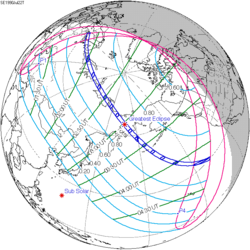| Annular eclipse | |
| Gamma | −0.9632 |
|---|---|
| Magnitude | 0.9329 |
| Maximum eclipse | |
| Duration | 363 s (6 min 3 s) |
| Coordinates | 59°36′S108°30′W / 59.6°S 108.5°W |
| Max. width of band | 953 km (592 mi) |
| Times (UTC) | |
| Greatest eclipse | 17:22:38 |
| References | |
| Saros | 125 (52 of 73) |
| Catalog # (SE5000) | 9463 |
An annular solar eclipse occurred at the Moon's ascending node of orbit on Wednesday, August 22, 1979, [1] with a magnitude of 0.9329. A solar eclipse occurs when the Moon passes between Earth and the Sun, thereby totally or partly obscuring the image of the Sun for a viewer on Earth. An annular solar eclipse occurs when the Moon's apparent diameter is smaller than the Sun's, blocking most of the Sun's light and causing the Sun to look like an annulus (ring). An annular eclipse appears as a partial eclipse over a region of the Earth thousands of kilometres wide. Occurring about 15 hours before apogee (on August 23, 1979, at 8:10 UTC), the Moon's apparent diameter was smaller. [2]
Contents
- Eclipse details
- Eclipse season
- Related eclipses
- Eclipses in 1979
- Metonic
- Tzolkinex
- Half-Saros
- Tritos
- Solar Saros 125
- Inex
- Triad
- Solar eclipses of 1979–1982
- Saros 125
- Metonic series
- Tritos series
- Inex series
- Notes
- References
Annularity was visible for a part of Antarctica. A partial eclipse was visible for parts of southern South America and Antarctica. This was the last of 40 umbral eclipses in Solar Saros 125.




































































































